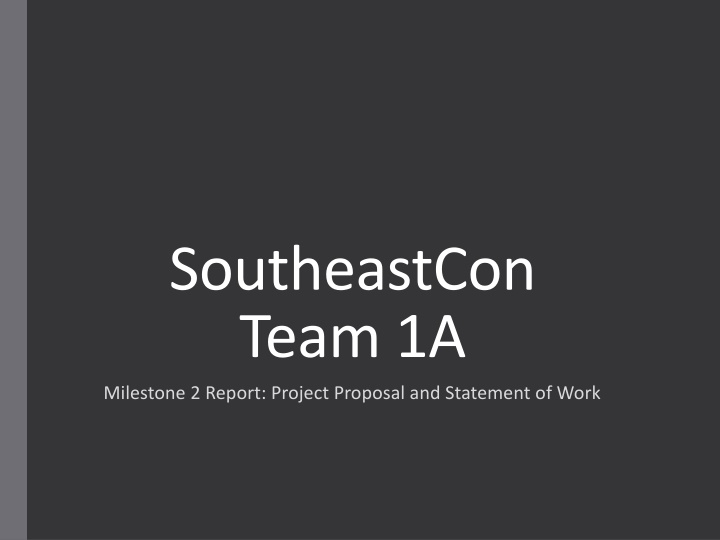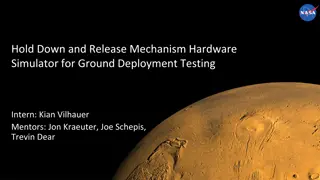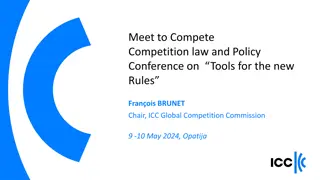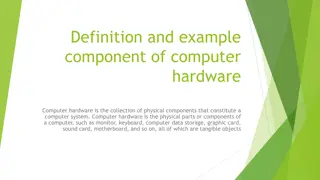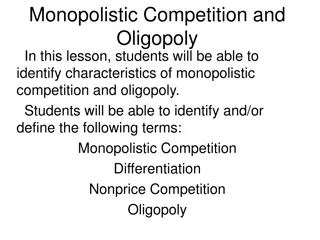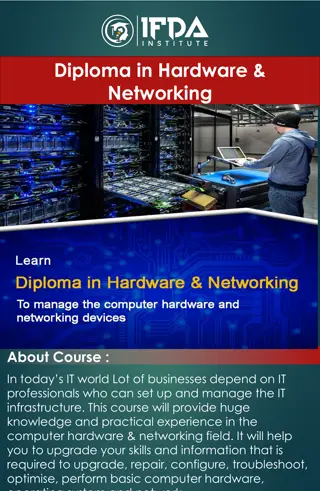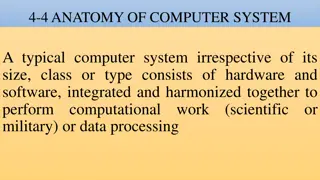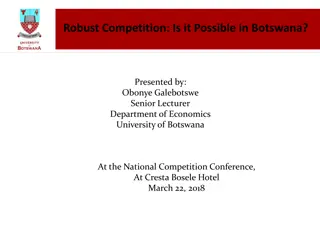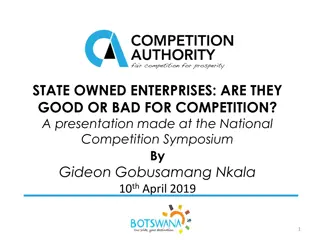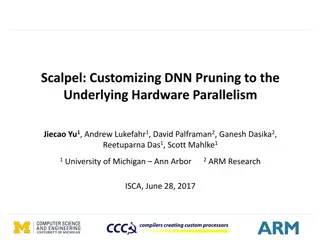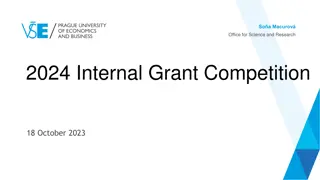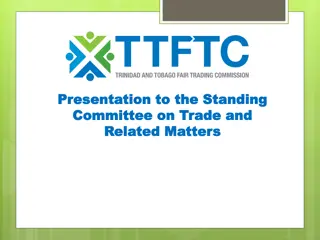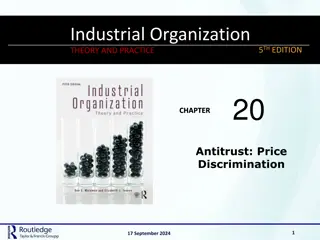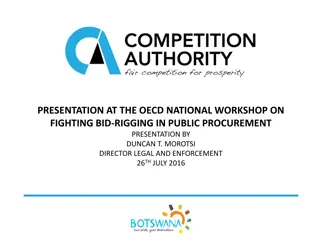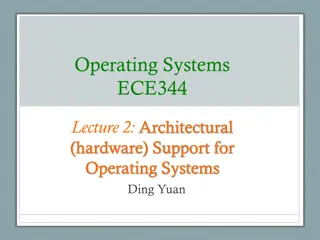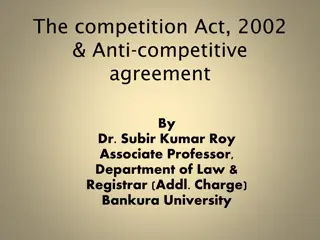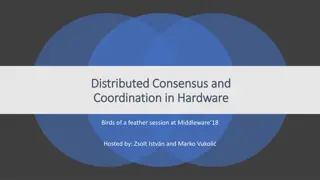IEEE SoutheastCon Hardware Competition Team Project
This report details the project proposal and statement of work for the IEEE SoutheastCon Hardware Competition Team 1A. The team, led by Nils Bjeren and faculty advisors, aims to create a fully autonomous robot capable of completing various tasks within set limitations. The report covers requirements, limitations, preliminary design featuring an Arduino Mega 2560 controller and omnidirectional wheels, and the project management team's roles. With a focus on technical details and team coordination, they strive to excel in the competition.
Download Presentation

Please find below an Image/Link to download the presentation.
The content on the website is provided AS IS for your information and personal use only. It may not be sold, licensed, or shared on other websites without obtaining consent from the author.If you encounter any issues during the download, it is possible that the publisher has removed the file from their server.
You are allowed to download the files provided on this website for personal or commercial use, subject to the condition that they are used lawfully. All files are the property of their respective owners.
The content on the website is provided AS IS for your information and personal use only. It may not be sold, licensed, or shared on other websites without obtaining consent from the author.
E N D
Presentation Transcript
SoutheastCon Team 1A Milestone 2 Report: Project Proposal and Statement of Work
IEEE SoutheastConHardware Competition Team 1A: Nils Bjeren Donovan Carey Christopher Lewis Kurt Marsman James Pace Ryan-David Reyes Julian Velasquez Faculty Advisors: Dr. Mike Frank Dr. Bruce Harvey Dr. Carl Moore Dr. Linda DeBrunner Presenter: Nils Bjeren EEL4911C: Senior Design 1 Fall 2014 September 24th 2
Requirements Sense a red LED (start condition) Navigate according to the white line Detect the sequence on a Simon Says game Actuate the correct button sequence on a Simon Says game Twist both knobs on an Etch-a- Sketch Presenter: Nils Bjeren Twist exactly one row of a Rubik s Cube Pick up and carry a single playing card 3
Limitations Robot must be fully autonomous Robot must fit inside a 1 by 1 by 1 box at the beginning and end of a run Robot cannot split into multiple pieces Robot must contain no flammable liquids, explosives, high pressures, or otherwise dangerous elements The course must be completed in less than 5 minutes Presenter: Nils Bjeren 4
Preliminary design Arduino Mega 2560 is the main controller Wheels are omnidirectional Mecanum DC motors with encoders are used for propulsion Line following subsystem: 9 IRR Sensors with dedicated Arduino Mini Pro Presenter: Nils Bjeren 2 challenge subsystems with dedicated microcontrollers: Rubik/Simon subsystem Etch-a-Sketch/Playing card subsystem 5
Project Management Team Manager: Nils Bjeren Coordinates the project as a whole Serves as interface between team and ECE faculty Is responsible for continued progress being made Head Programmer/Control Engineer: Ryan-David Reyes Oversees and maintains stable versions of all code Implements omnidirectional motor control Implements communication between subsystems Head Mechanical Engineer: James Pace Has the final say on all mechanical/structural decisions Serves as interface between team and ME faculty Assures the structural integrity of the chassis Presenter: Nils Bjeren 6
Project Management Financial Advisor/Power Engineer: Julian Velasquez Maintains budget and purchase record for the team Calculates power requirements Chooses battery units to satisfy power requirements Secretary/Systems Engineer: Kurt Marsman Creates and maintains meeting minutes and other required documents Creates and maintains the system that ensures reliable start Assists in development of Rubik/Simon Says subsystem Systems Engineer: Donovan Carey Creates the system-level design of the Etch-a-Sketch/Playing Card subsystem Submits software requirements to the Control Engineers Performs mechanical testing of the subsystem Presenter: Nils Bjeren 7
Project Management Control Engineer: Christopher Lewis Works with Etch-a-Sketch/Playing Card systems engineer to establish software requirements Writes software for the subsystem Mentor and assist other team members with programming Presenter: Nils Bjeren 8
Concept Generation and Selection Christopher Lewis Donovan Carey
Movement / Line Following Design Differential Steering vs. Omnidirectional Steering Movement Design Control (0.4) Flexibility (0.6) Total Differential Steering 4 1 2.2 Omnidirectional Steering 3 5 4.2 Presenter: Christopher Lewis Infrared Reflective Sensors vs. Camera 10
Chassis Design U-Shaped Chassis Hole in the Center Chassis Square Shaped Chassis Chassis Design Support of Manipulation (0.4) Structural Integrity (0.5) Ease of Manufacture (0.1) Total U-Shaped 4 2 2 2.8 Presenter: Christopher Lewis Hole in the Center* 4 3 3 3.4 Square Shaped 3 5 5 4.2 11
Communication NO outside communication with the robot. Communication Protocols I2C Lower Complexity in wiring More difficult to implement Communication errors affect entire system RS232 (serial) Requires Wiring from Mega to each subsystem Improved Reliability due to errors only affecting the local subsystem. Presenter: Christopher Lewis 12
Manipulator Arms Pros: Provides a simple means of interface between the autonomous robot and the different challenge Can minimize the number of manipulators if similarities are found between the challenge games Cons: Robot must be perfectly aligned with the toys Presenter: Donovan Carey 13
Simon Says/ Rubiks Cube The design for playing the Simon Says game and the Rubik s cube challenge both require the same circular motion. Rubik s Cube Implementation Simon Says Implementation Lower arm over the Simon game Hold the Rubik s in place using some type of gripping tool Detect the game sequence using sound detection from a microphone Lower the arm onto the Rubik s cube Analyze the sequence given by the game Use the servo on the arm to turn the top row of the Rubik s cube an entire 180 degrees Presenter: Donovan Carey Use the servo on the arm move the penetrator to the desired button Lower the entire arm to press the desired buttons in the sequence given 14
Presenter: Donovan Carey Figure 1: Custom Simon Says/Rubik s Cube interface 15
Etch a Sketch/ Playing Card The design for the etch and sketch arm requires movement in the z- direction which can be used to pick up the playing card using adhesive. Etch a Sketch Implementation Playing Card Implementation Lower the arm onto the stack of cards Use a servo to lower the arm onto the game Use adhesive on arm to lift the playing card from the stack Align the motors perfectly with the knobs using an adhesive Use the arm to then lift the card Use the frictional contact of the adhesive to work with the motors for movement of the knobs Presenter: Donovan Carey Carry the playing card across the finish line Use the knobs to sketch IEEE into the toy in a timely fashion 16
Power Systems We are looking at using two Lithium Polymer(LiPo) for the power distribution to the robot. One of the batteries is intended for the propulsion system while the other will be used to power the manipulator subsystems. Propulsion Devices Manipulator Devices Line Following Sensors (x9) DC motors with Encoders (x4) DC motors (x3) Servos (x2) Arduino Mega 2560 microcontroller Presenter: Donovan Carey Arduino Redboard (x2) Arduino Mini 17
Alternative Solutions Power System Etch-a-Sketch Manipulation Lithium Polymer (LiPo) Claws Nickel-metal hydride (NiMH) Adhesive between the mounted motors Simon Says Sequence Detection and knobs Light Detection Frictional Contact on the side of the Sound Detection (frequency counter vs FFT) knob Color Sensor Rubik s Cube Rotation Simon Says Interface Use motor and adhesive Presenter: Donovan Carey Four-bar-linkage (single piston) Servo attached to a manufactured piece Four pistons to rotate the row from the outside Claw rotating around horizontal plane 18
Preliminary System- Level Design Ryan-David Reyes James Pace
Block Diagram Presenter: Ryan-David Reyes 20
Specifications Chassis Size: Width: 7 in. Length: 7 in. Height: in. from ground Propulsion Motors: 110 oz-in. stall torque Encoder: 1920 CPR 350 RPM 300 mA free run current Mecanum Wheels: 2 in. radius Master Microcontroller Specs: Atmega 2560 54 DIO, 16 AIO 4 Serial IO Batteries: 2x LiPo 2.3 Ah Presenter: Ryan-David Reyes 21
Specifications Photoresistor (Sense Start) 5k-100k Ohm variable resistance Line Following Sensors: IR Reflectivity Phototransistor output in. effective range Slave Microcontroller Atmega328p 14 DIO Presenter: Ryan-David Reyes 22
Specifications Rubik s Cube Arm Servo 1 Servo 2 Microphone 12 oz-in stall torque 180 degrees of rotation 93 oz-in stall torque 360 degrees of rotation 5V Supply Requires 500x Output Amplification Slave Microcontroller Atmega328p 14 DIO Presenter: Ryan-David Reyes 23
Specifications Etch-A-Sketch Arm DC Motors Servo Slave Microcontroller Atmega328p 14 DIO 20 oz-in stall torque 120 RPM 12 oz-in stall torque 180 degrees of rotation Presenter: Ryan-David Reyes 24
Overall Constraints 1 ft. by 1 ft. by 1 ft. size constraint at beginning and end. Must be able to complete track in 5 minutes. Robot must not split completely apart. Presenter: James Pace 25
Preliminary Overall Design Presenter: James Pace 26
Lower Level Presenter: James Pace 27
Electronics Level Presenter: James Pace 28
Arms Presenter: James Pace 29
Budget Julian Velasquez
Budget Budget estimate for milestone 1 Category Cost Wheels $80.00 Motors $300.00 Batteries/Chargers $150.00 Presenter: Julian Velasquez Microcontrollers $300.00 Electronics $200.00 Misc. Mechanical Parts $170.00 Total: $1,200.00 31
Budget Budget as of 10/17/14 Purpose Items Cost Simon Frequency Analysis Miscellaneous Electronics $11.47 Propulsion Motor Drivers $47.95 Battery Charger for Propulsion/Manipulators Batteries Battery Charger $40.08 Batteries for Manipulators Battery $27.75 Simon/Rubik s Manipulator Servo Motor $19.40 Presenter: Julian Velasquez Propulsion Miscellaneous Equipment $51.89 Propulsion Motors for Propulsion $177.25 Etch-a-sketch manipulator Gearmounts $20.35 Etch-a-sketch manipulator Miscellaneous equipment $20.11 Mecanum Wheels Propulsion $71.76 Total: $508.01 32
Budget Personnel Cost Personnel Total Hours per Semester Total Hours Worked Both Semesters Total Base Salary ($30 per hour) Total Salary + Fringe Rate of (29%) 1 Group Member 192 384 $11,520 $14,861 Whole Team (7 Members) Direct and Overhead Costs 1,344 2,688 $80,640 $104,026 Presenter: Julian Velasquez Direct Cost Direct Cost + Fringe Rate + Overhead rate (45%) Direct Cost + Overhead Rate (45%) $81,148 $151,574 $117,665 Overhead costs refers to an ongoing expense of operating a business. I.e. rent, gas, electricity, and labor burden. 33
Budget Total Project cost Category Expense ($) Supplies and Small Items (Current) $508.01 Additional Supplies and Small Items (Projected) $691.99 Direct Cost + Fringe Rate + Overhead rate (45%) $151,573.74 Total Project Cost: $152,773.74 Presenter: Julian Velasquez Fringe rate is the cost of an employee s benefits divided by the wages paid to an employee for the hours worked. 34
Schedule Julian Velasquez
Schedule Event Date Individuals Responsible Simon Arm Prototype Complete 11/6/2014 Julian, Nils Etch-A-Sketch Prototype Complete 12/16/14 Donovan, Chris, James Line Following Complete 11/4/14 Nils, Ryan Presenter: Julian Velasquez Final Chassis Built 2/4/15 James Local Competition Late February Whole Team 36
Risk Assessment Kurt Marsman
Budgetary Risks Design Requirements Not Met Buying wrong parts Proper planning Scheduling Overall bottom line Gantt chart Presenter: Nils Bjeren 38
Hardware Voltage and Current Associated with Design Motor Drivers Motors on Robot Breaking Double check specs Presenter: Nils Bjeren Solarbotics L298 Compact Motor Driver 39
Software Errors in Code Version control GIT No Walls on Track Refine code early on Have people ready to catch the bot Presenter: Nils Bjeren 40
Performance Risks Precision Positioning Motor Encoder Decoder Arm Alignment Axis of rotation Grabber Design Sideways Movement Line following Forward motion with turn in place Presenter: Nils Bjeren 41
